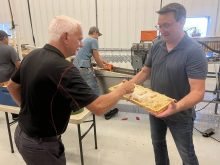Cars and trucks are a menace to trains, especially when roads and railway crossings meet.
More than 100 people were killed in Canada last year and about 75 injured in railway grade crossing incidents or while trespassing on railway property.
Most of these incidents could have been prevented and education is the key, says Canadian National Railway’s top cop.
Serge Meloche said people have routines in life and tend to take things for granted while driving familiar roads.
“A lot of people are complacent around tracks,” said Meloche, police chief for CN.
Read Also

Vintage power on display at Saskatchewan tractor pull
At the Ag in Motion farm show held earlier this year near Langham, Sask., a vintage tractor pull event drew pretty significant crowds of show goers, who were mostly farmers.
Even if they see a train or hear the whistle, they often misjudge the danger. Men older than 35 are more likely to be in a vehicle-train collision because they speed up to the crossing and then can’t stop in time.
Trains travel faster than most realize: up to 100 km-h for a freight train and up to 160 km-h for passenger trains.
Meloche said with the weight behind it, a train needs a kilometre or more to stop. People also ignore the fact that a train can’t swerve around another vehicle.
Meloche said CN is improving its safety record using a combination of education, better technology and enforcement.
“A lot of it starts with the driver of the car – 100 percent of the accidents are preventable.”
CN offers education courses for drivers of buses, trucks, ambulances and fire equipment, as well as members of all-terrain vehicle and snowmobile groups.
Elementary school students hear the safety message with the help of a miniature train called Obie.
On April 24, at the start of Rail Safety Week, the company opened a website for children at www.cn.ca/obie, featuring Obie and his friend Max the engineer, to help children learn about rail safety in a fun and entertaining way.
“The real-life Obie is an excellent safety ambassador, but he cannot be everywhere,” Meloche said.
“We want to reach even more children with our safety messages. Obie’s website is a fun way for kids to learn about rail safety guidelines and about why it is important that they follow Obie’s safety tips.”
For high school students, Meloche said the safety message comes wrapped in a mock accident, using drama club students from local schools.
Technology has also been helping rail safety. Meloche said lights at rail crossings are being replaced with LED bulbs that are brighter and more visible.
CN is also adding reflector tape to its crossbuck signs at crossings and last year it began adding the tape along the length of its rail cars.
It has done 14,000 rail cars out of its total fleet of 80,000 in Canada and the United States.
















